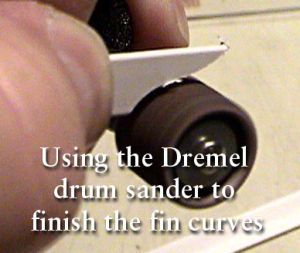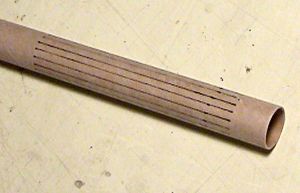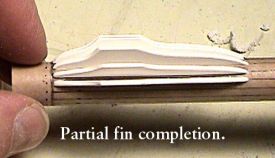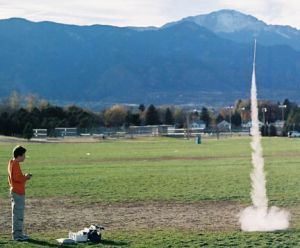Scratch Iridium Flare Original Design / Scratch Built
Scratch - Iridium Flare {Scratch}
Contributed by Jeff Lane
| Manufacturer: | Scratch |

Brief:
A 16FNC rocket for C6-10s with parachute recovery and an ornamental tube fin.
Construction:
18-inch BT-5,.04 by .25 extruded styrene (manufactured by Raboesch and
purchased at Hobby Town), plastic Estes nose cone, prepared acetate, engine
block, old engine casing, Kevlar®/elastic
shock cord, 12 inch Estes chute, and nose weight.
Have you ever designed a rocket specifically for a really odd engine? Well, that's what this is. I have some old composite Apogee C6-10s and built this rocket specifically for those engines. It's 2.375 ounces and 20.125 inches long.
The ten second delay is a real challenge. It dictates a minimum-diameter body tube in order to achieve ejection while still airborne. When first built, the rocket was 0.68oz, but in Rocksim it slowed too quickly during the upwards coast and 40 grams of weight had to be added to optimize the coast. The top 1.5 inches of the body tube is permanently epoxied to the nose cone. A portion of old engine casing is used as a bulkhead and the whole bulkhead/payload/nose cone section is filled with weight and epoxy. The screw eye for parachute and shock cord attachment is also embedded in the epoxy. Polishing the nose cone (Future floor polish) achieved 100 feet of additional altitude in Rocksim and some critical additional time.
The fins are simply 0.04 x 0.25 inch extruded styrene cut to 2.375 inch length. The PDF file includes the template. A bit of excess is removed by scoring and then breaking, followed by rounding off the curves with a drum sander on a Dremel tool. The first fin is used to mark the rest in order to have reasonable consistency. The tube was marked with a 16-fin wrap and then the fins were glued on with CA. It took about 1.5 hours to cut, grind, and attach the fins.
 Normally,
I wouldn't bother to put a sophisticated shock cord in a BT-5 rocket, but this
was an exception because of the mass involved. On the fourth launch, the
tri-fold paper mount detached (the first time for such a detachment in hundreds
of launches). So an engine block was added 12.5 inches from the tip of the nose
cone and a Kevlar®
shock cord was tied to it, gluing it in place with yellow glue. Thin CA was
added to half an inch of body tube at the forward end to strengthen it and a
double knot tied in the Kevlar®
to keep the body tube from zippering. Forty inches of 1/8 inch elastic finished
off the shock cord.
Normally,
I wouldn't bother to put a sophisticated shock cord in a BT-5 rocket, but this
was an exception because of the mass involved. On the fourth launch, the
tri-fold paper mount detached (the first time for such a detachment in hundreds
of launches). So an engine block was added 12.5 inches from the tip of the nose
cone and a Kevlar®
shock cord was tied to it, gluing it in place with yellow glue. Thin CA was
added to half an inch of body tube at the forward end to strengthen it and a
double knot tied in the Kevlar®
to keep the body tube from zippering. Forty inches of 1/8 inch elastic finished
off the shock cord.
The tube fin is made of 0.005 inch wet-media acetate, and represents several firsts for me. This is the first tube fin rocket I've ever built. It's the first time I've ever printed from an ink jet printer on wet media acetate (the name of the rocket is printed on the outside). It's the first time I've ever frosted acetate with my sandblaster airbrush (used on the inside of the wrap).


The tube fin (included in the PDF file) is printed flat. The clear areas were masked off with tape, sandblasted to achieve the frosted effect, then cut it out and wrapped it around the fins with CA at the point where the ends of the acetate come together. A tiny drop of thin CA was then wicked into each of the remaining leading edge/tube fin joints.
Finishing:
The paint is catalyzed automotive acrylic enamel, with Maserati metal flake
charcoal for the fin area and Jaguar champagne metal flake then added for the
swoosh pattern at the front. The mask for the pattern is included in the PDF
file, which was printed on prepared frisket and then cut out by hand.

Flight:
The first four naked launches were tests with 1/2A and A engines. The first
three were stable off the rod under thrust, but became unstable upon coasting.
Rocksim predicts a static margin of 3.64, but with an earlier multi-finned
rocket design doing the same thing, it wasn't surprising that this one was not
stable either. The nose weight was added before the fourth launch at which
point stability became a non-factor with a predicted static margin of 28.42.
The fifth launch was attempted with a C6-10. It had partial ignition with the rocket not clearing the launch rod then sliding back down. Makes me wonder if age affects the AP propellant as this particular engine was manufactured a few years ago. I'll try again although not with the same engine.
Summary:
PROs: Sleek-looking and is not your average rocket. Flies nice.
CONs: Packing even a twelve inch chute is hard in a BT-5. If you have an engine ejection or ejection charge failure at 1500 feet, this is one seriously dangerous China Syndrome lawn dart because you wouldn't be able to see it coming back. The weight combined with the small diameter and potential velocity would give it armor-piercing capabilities.
Sponsored Ads
 |
 |











